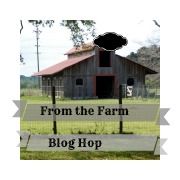 A lot of people want to be more involved in producing their own food, but think they can't because they don't have the "proper" setup. Maybe the yard is tiny. Maybe it's shaded or the soil is hard clay. I have a lot of those same issues, but still grow a lot of food. I thought I would share my back yard with you so you can see that even with a challenging property, you can still grow some of your own food. The photo on the left is of my backyard when we bought the property. It is late summer when this picture was taken. The picture below is the property in spring before the leaves have really filled out.
A lot of people want to be more involved in producing their own food, but think they can't because they don't have the "proper" setup. Maybe the yard is tiny. Maybe it's shaded or the soil is hard clay. I have a lot of those same issues, but still grow a lot of food. I thought I would share my back yard with you so you can see that even with a challenging property, you can still grow some of your own food. The photo on the left is of my backyard when we bought the property. It is late summer when this picture was taken. The picture below is the property in spring before the leaves have really filled out.My property is 1/5 acre total, about half of that is the backyard. My soil is clay or clay loam depending on the part of the yard. There is also a lot of gravel in the soil, so I try to remove as many stones as I can while digging the bed. Whenever I work in the garden, I remove any rocks I see. Rains expose more over the course of the season, so in a year, I remove a lot.

The property line is all trees, so the perimeter is completely shaded. There is a huge tree on one side that casts shade over half of the backyard. There is only one section that gets good sun, that's the two horizontal beds . The two vertical beds get partial shade, but enough sun to grow food. I will be digging another bed along the back where the fire pit is now, as that area also gets good sun. One lovely benefit of the treeline: I have 7 mulberry trees, and when in season, after work each day I walk around and pop fresh berries in my mouth as a perfect snack. Can't beat that.
To maximize our sunny areas, Trucker has been thinning out the treeline, removing a couple of medium-sized trees that were in the way. He also ruthlessly prunes back the trees to give me a little more sunlight. While I loved the privacy that the thick stand of trees provided, I like homegrown tomatoes better.
Since I knew what areas got the best sunlight, I planted my sun-lovers in those beds, and used the other beds for vegetables that tolerate a bit of shade. The sunniest beds housed my tomatoes, peppers and eggplants. The partially shaded beds were home to peas, carrots, radishes, spinach and lettuce. Last year, the tomatoes went nuts! We had more than we could eat fresh. I was able to dehydrate several gallon containers worth, which we are just now finishing in late April. I was even able to sell some of the green tomatoes to one of Trucker's coworkers. Even with the limited space, we got a huge harvest.
 This area is under a neighbor's tree just over the property line. It casts pretty heavy shade for a lot of the day, but gets some sunlight in the evening. It was overgrown in weeds and just looked bad (left photo). I dug out all of the weeds, dug the bed and worked in some compost. I smoothed it out into a seedbed. I planted it with beans, lettuce, spinach, mustard, swiss chard, onions and sprouting broccoli (right photo). All of these can tolerate some shade, but won't give as good a harvest as if they got more sunlight. Even with a more limited harvest, it's better than nothing, and seeds are cheap enough. Trucker bought me a ton of seeds this year, so I can be free with planting.
This area is under a neighbor's tree just over the property line. It casts pretty heavy shade for a lot of the day, but gets some sunlight in the evening. It was overgrown in weeds and just looked bad (left photo). I dug out all of the weeds, dug the bed and worked in some compost. I smoothed it out into a seedbed. I planted it with beans, lettuce, spinach, mustard, swiss chard, onions and sprouting broccoli (right photo). All of these can tolerate some shade, but won't give as good a harvest as if they got more sunlight. Even with a more limited harvest, it's better than nothing, and seeds are cheap enough. Trucker bought me a ton of seeds this year, so I can be free with planting.A side benefit for the greens is that the shade will keep them from getting so overheated, so they might not bolt as quickly. At my old apartment, I had a 2'x2' bed that I seeded to lettuces. It got only 1-2 hours of sun a day, but grew well and didn't bolt in the summer heat. I had greens from late May through late October.
 My soil is clay or clay-loam depending on the area. The areas directly under trees are clay-loam or even loam, which makes sense due to the leaves falling and decomposing into the soil. I do not throw away any yard waste from our property. All leaves are raked and used in mulching or composting. All weeds are either left to dry and then composted (before they've gone to seed) or burned and the ash worked into the soil (if they have gone to seed). Branches and trees are chopped and used in hugelkulture-type projects, or they are burned during one of our bonfires with friends and the ash worked into the garden beds. I sometimes use straight branches as trellises for beans. After mowing the lawn, I allow the clippings to dry for a few days, then rake and store to use as a brown in my compost. In addition, I compost every scrap of organic matter I can-even the weird stuff. Sometimes I take eggshells home from my job at the bakery to make into a great fertilizer for tomatoes to prevent blossom end rot. I've even been known to scoop up bags of leaves from the curb.
My soil is clay or clay-loam depending on the area. The areas directly under trees are clay-loam or even loam, which makes sense due to the leaves falling and decomposing into the soil. I do not throw away any yard waste from our property. All leaves are raked and used in mulching or composting. All weeds are either left to dry and then composted (before they've gone to seed) or burned and the ash worked into the soil (if they have gone to seed). Branches and trees are chopped and used in hugelkulture-type projects, or they are burned during one of our bonfires with friends and the ash worked into the garden beds. I sometimes use straight branches as trellises for beans. After mowing the lawn, I allow the clippings to dry for a few days, then rake and store to use as a brown in my compost. In addition, I compost every scrap of organic matter I can-even the weird stuff. Sometimes I take eggshells home from my job at the bakery to make into a great fertilizer for tomatoes to prevent blossom end rot. I've even been known to scoop up bags of leaves from the curb.Regular applications of compost, manure and mulch can save a bad soil. I already see a difference in my garden beds from last year. They are fluffier and darker than last year. My parents' soil used to be hard clay. We would dig up clay and sculpt with it. After a decade of adding as much organic matter as they can, they have a very nice, productive plot with good, soft, rich soil.
 If there is no option of growing outside-say a HOA restriction, renting, apartment living or just in winter, grow indoors! This one windowsill of lettuce and spinach provided some much needed fresh salad during months when we couldn't grow outdoors. We got our first harvest in December and got our last harvest a week ago (Mid-April).
If there is no option of growing outside-say a HOA restriction, renting, apartment living or just in winter, grow indoors! This one windowsill of lettuce and spinach provided some much needed fresh salad during months when we couldn't grow outdoors. We got our first harvest in December and got our last harvest a week ago (Mid-April).If you have any sunny windows, fill them up with lettuce, pea shoots, cherry tomatoes, green onions, radishes, herbs, spinach, beets and carrots. Even if you have no sunny windowsills, you can sprout beans and seeds in a cupboard.
My house faces south so the front yard gets much more sunlight than the back garden. This year, I'm branching out into edible landscaping. I have chosen several pretty plants that I am going to mix into the flower beds in front. Scarlet Runner beans have beautiful leaves, stunning flowers and attract hummingbirds making them a perfect decorative plant, and I get green beans! Ruffly red and speckled lettuces will fill in empty spots between flowers. Large planters matching the house will hold Burgundy Okra, Milkmaid nasturtiums, and Red Sails lettuce. One will go on each side of the driveway.
Being able to grow your own food is a magical thing. It tastes absolutely incredible, is much fresher than anything you could buy anywhere, and it's incredible to casually mention during a dinner party "Oh, those tomatoes? I grew those."
Shared on:













Thanks for sharing your growing food tips at the Home Acre hop!! I hope you join us again!
ReplyDeleteSandra
I was so glad to find this posting. My yard is mostly shade since, like you, my property is lined with trees, in my case mostly 100 year old oaks and pines. I have an area with sun where I grow sun loving plants, but I've been trying to figure what to do with the very shady areas (most of the back and front yards. You gave me some ideas. Thanks.
ReplyDelete